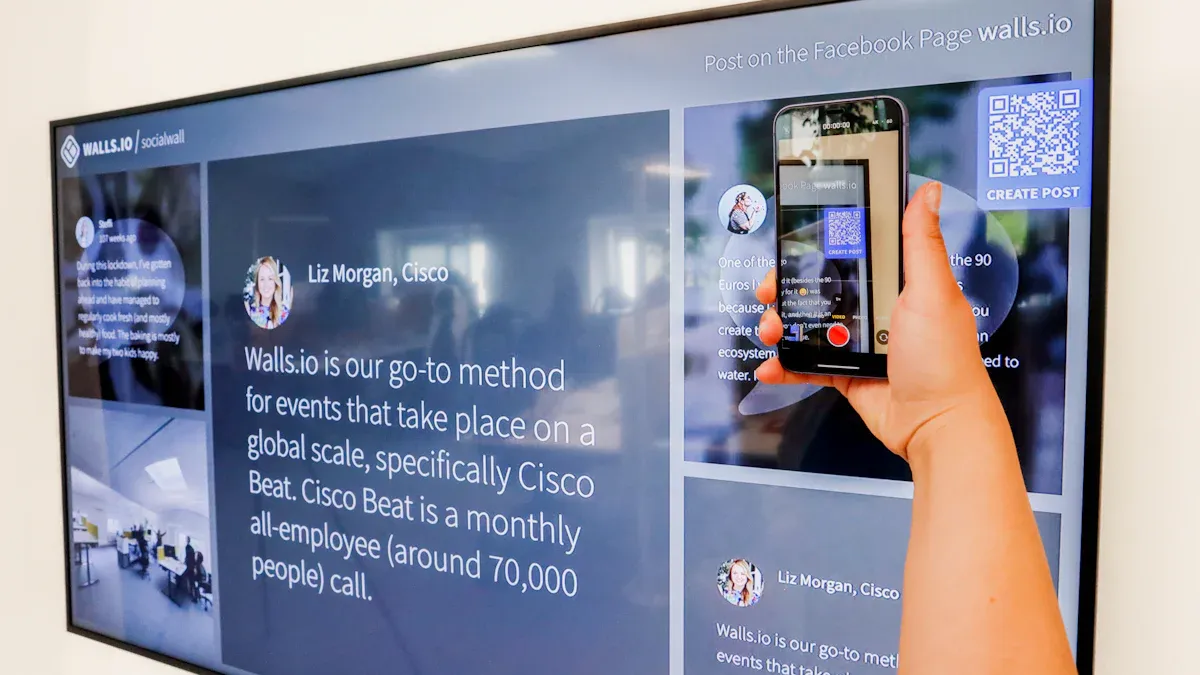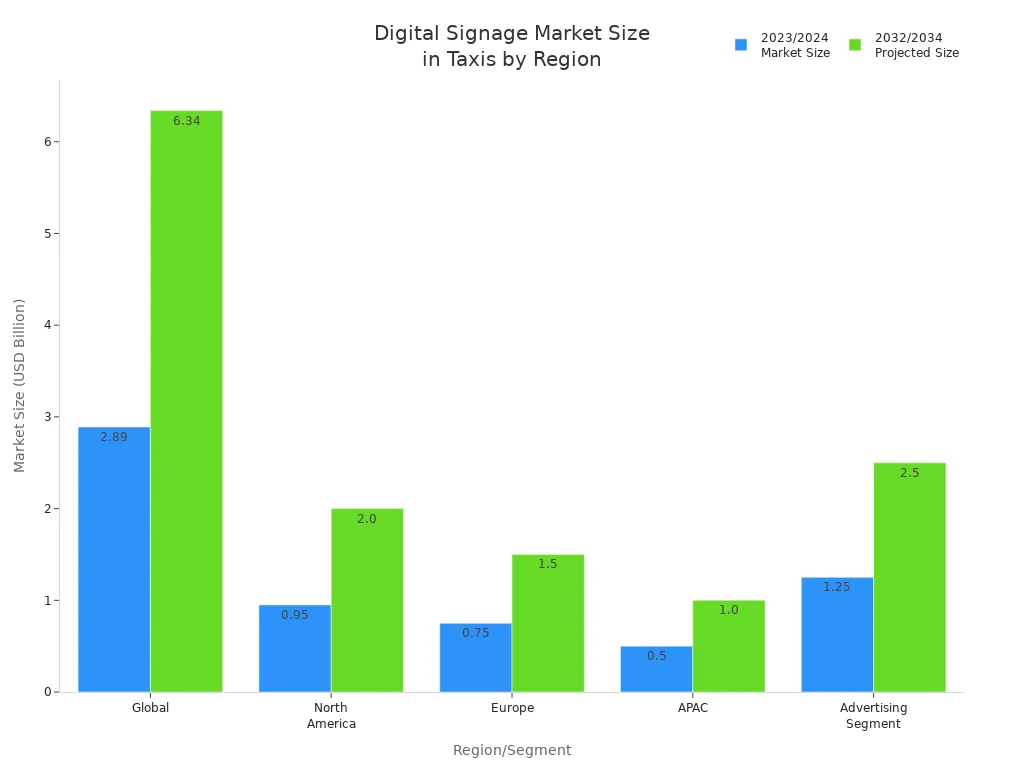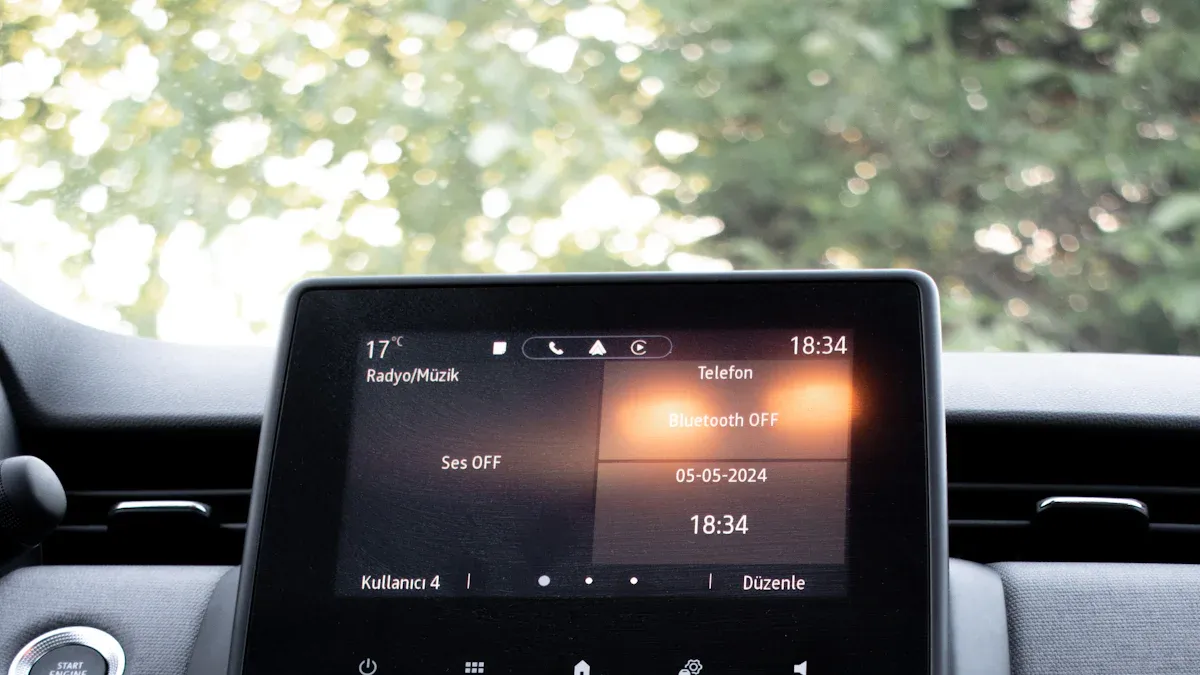
A position-triggered advertising system in taxis uses GPS data. It shows ads that fit where the taxi is right now. Digital signage shows changing content. This content may not match a certain place. This difference makes taxi ads more useful and timely for riders. Studies show position-triggered systems in taxis help people pay attention 40% more. They also lower costs by 30%.
Brand recall for digital signage stays high, with 82% aided recall.
Context-aware taxi advertising helps target ads better. It makes passengers and advertisers happier. This leads to a better experience for everyone.
Key Takeaways
Position-triggered advertising uses GPS to show ads. These ads match where the taxi is right now. This makes ads more interesting for people riding in the taxi.
Digital signage shows different ads on bright screens inside taxis. It gives fun things like games, videos, and news. These things update fast from the cloud.
Both systems make the ride better for passengers. They also help taxi owners make money. Digital signage costs more at first. Position-triggered ads need good GPS and planning.
Advertisers should use position-triggered ads to reach riders at the best time. They should use digital signage to share messages with lots of people.
Taxi operators must choose the system that works for their routes. They need to think about their technology and business plans. This helps them show ads that are helpful and keep riders interested.
Digital Signage

How It Works
Digital signage in taxis uses new technology to show changing content. Each taxi has a screen like LED, LCD, or OLED. The screens are about 10 inches and show clear pictures. They connect to the internet with 4G, 5G, Wi-Fi, or Bluetooth. This lets people update ads from far away and right away. Operators use special systems to plan and change ads from anywhere. The screens use Android, so they work well and save power on long rides.
Real-time geo-targeting is important for taxi ads. GPS and geofencing help the screens change ads based on where the taxi is. The system keeps track of where and when ads play. This helps advertisers pick the best places and check how well ads do. Some screens let passengers touch them to play games or see travel info. These screens can show videos, music, and pictures, making rides more fun.
Digital signage can change fast. Operators can update ads right away, show emergency news, or share local stories. This helps taxi companies and advertisers send the right messages to riders.
Note: Digital signage in taxis uses cloud platforms to control content. This makes sure each screen shows the right ad at the right time.

Use Cases
Digital signage in taxis has many uses:
Advertising: Companies show ads that fit the place and time. AI and GPS help send the right ad to the right spot.
Passenger Information: Screens give updates about the trip, routes, and emergencies.
Entertainment: Passengers can watch videos, play games, and use fun apps.
Public Service: Screens show city guides, tips, and public news.
Interactive touchscreens: Passengers can play games, get directions, or pay for things.
Interactive features: Voice tools and cloud systems make updates easy and help riders join in.
Monetization: Taxi owners make money by selling ad space on screens.
Accurate Information Delivery: Passengers get updates about when they will arrive or if there are delays.
Interactive touchscreens: These screens help people find their way and offer quizzes or news.
Digital signage makes taxi ads more useful and flexible. Touchscreens and geo-targeting help ads reach the right people. Passengers get fun and helpful info, and taxi owners find new ways to earn money.
Position-Triggered Advertising System in Taxis

GPS and Location Data
A position-triggered advertising system in taxis uses GPS to find where the taxi is. The system works with the taxi app and watches the planned route. It checks the taxi’s spot as it drives in the city. The system uses a geofence database. This database puts invisible lines around big landmarks or busy places. When the taxi goes into one of these areas, the system notices and gets ready to show geo-targeted ads.
Operators download ads ahead of time. They pick ads based on what people might like, why they are traveling, and the time of day. This helps make sure ads match what the passenger wants and the trip’s details. The system sends a message, like a buzz or a pop-up, to the passenger’s phone. This message asks the passenger to look at the ad. The ad could have 3D models, brand pictures, or short videos.
Tip: GPS and network tools work together to give smooth ads during taxi rides.
Context-Aware Advertising
The position-triggered advertising system in taxis gives ads that change with each route. As the taxi moves, the system shows ads that fit the place and time. This makes passengers pay more attention and helps ads work better. Passengers see ads for places like restaurants or stores as they pass by. The system uses geo-targeting to make sure ads are right for the moment.
Taxi ads get more fun with AR content. Passengers can see brand pictures or videos about what is around them. The system watches how people use the ads and what they think. This helps make ads better next time. Advertisers get more people to look at their ads and can aim at the right group. Taxi owners make more money by showing ads that fit each trip.
The position-triggered advertising system in taxis makes ads more useful.
Passengers get ads that match where they are and why they travel.
Advertisers can reach the right people easily.
Taxi Advertising Comparison
System Operation
Digital signage works with screens inside taxis. These screens connect to the cloud and get new ads from far away. Operators use software to plan and control ads. The system needs good internet and strong screens like LED or LCD. Position-triggered advertising uses GPS and geofencing. It checks where the taxi is and shows ads in certain places. Operators load ads ahead of time for each route and passenger type. The system sends alerts or shows ads at important times during the ride.
Note: Both systems need good technology to work well. Digital signage needs strong hardware and steady internet. Position-triggered systems need accurate GPS and fast data.
Targeting
Digital signage uses location tools to send special messages. Operators mix map data and people info to pick ads. AI and interactive tools help change ads for different groups. Position-triggered advertising uses real-time actions to show ads. The system starts ads when the taxi enters a set area or gets close to a rival. This way, ads match what is happening right now. Operators use signals and events to reach the right people. For example, a restaurant ad pops up as the taxi passes by.
Digital signage targets wide groups using map and people data.
Position-triggered ads target right away using actions and place.
Both systems help reach more people and get their attention.
Content Relevance
Digital signage shows changing ads that can update by time, place, or what riders like. Operators can change ads fast and react to local news or problems. The system can show videos, pictures, and let people join in. Position-triggered ads match the taxi’s spot and path. The system makes sure ads fit the trip and what’s nearby. Passengers see ads for close stores or fun places. This helps riders pay more attention and enjoy the ride.
Tip: Ads work better when systems use live data and smart triggers.
Cost and Implementation
Aspect | Digital Signage Details | Position-Triggered Advertising Details |
|---|---|---|
Hardware Cost | No cost info given. | |
Software/Service Fees | Cloud costs about $99 per device yearly; full service is $99 per month per place. | No fee info given. |
Deployment Timeline | Takes weeks for planning, making ads, shipping, and setup. | No timeline info given. |
Deployment Approach | Turnkey providers set up before delivery to save time and avoid mistakes. | No approach info given. |
Challenges | Rules, driver safety, and privacy are big issues for setup. | Same problems may happen. |
Digital signage needs money for screens, software, and service. Setting it up takes weeks and needs planning and work. Position-triggered ads may cost different, but there is no info. Both systems must follow rules and protect privacy.
Passenger Experience
Taxi ads try to make rides better for passengers. Digital signage gives fun and news with videos, games, and updates. The system lets people play and learn during the ride. Passengers have more fun and get helpful info. Position-triggered ads show offers that fit where the rider is and what they like. The system makes each trip feel special and keeps riders interested. Passengers get deals and ads as they move through the city.
Both systems make rides better and get more attention.
Digital signage gives fun and info.
Position-triggered ads give smart offers and quick ads.
Environmental considerations: Both systems use energy-saving screens and cloud tools to help the planet. Taxi owners pick tech that works well and is good for the earth.
Pros and Cons
Digital Signage Pros
Digital signage in taxis has many good points for advertising. Operators can change ads fast and show them to the right people. The system lets ads update right away, so messages stay new. Advertisers can use pictures, videos, and moving images. This keeps passengers interested and makes them pay more attention.
The screens work all day and night, so ads are always seen. Taxi companies can pick different ads for different times or places. Passengers can touch the screen to play games or learn more. This makes the ride better and helps brands talk to people.
Digital signage is flexible, shows cool content, and is easy to see. This makes it a strong choice for taxi ads.
Key advantages:
Shows many kinds of content and lets people join in.
Easy to control and plan from far away.
Digital Signage Cons
Digital signage also has some problems. Buying screens and setting them up costs a lot at first. Operators must pay for software and cloud services. Fixing and updating the system adds more costs. Sometimes, tech issues or bad internet stop the ads.
Taxi companies need to teach workers how to use the system. They also need to make new ads often. If screens show too many ads or repeat them, riders may get bored. Rules about privacy and safety can make setup harder.
Main disadvantages:
Must pay for software, fixes, and updates.
Tech problems or no internet can stop ads.
Workers need training and must make new ads.
Riders may get tired of ads if not managed well.
Position-Triggered System Pros
Position-triggered systems use GPS to show ads that fit where the taxi is. This gives passengers ads that match the places they pass. Advertisers can pick people based on where they are and what they might want. This makes people pay more attention and helps ads work better.
The system can send offers or alerts when the taxi enters a special spot. Passengers see ads for stores, food, or events nearby, which makes the ride nicer. Taxi owners can earn more by showing ads that fit each trip.
Key advantages:
Shows ads that match real-time location.
Gets more people to notice and like the ads.
Sends offers and alerts at the best time.
Helps taxi owners make more money per ride.
Makes the ride better with ads that fit.
Position-Triggered System Cons
Position-triggered systems have some hard parts too. The tech needs good GPS and a strong network. If GPS is weak or slow, ads may not show at the right time. Operators must plan and load ads for many trips and people, which is hard.
Tracking where people go can cause privacy worries. The system needs updates often to keep ads new. If not managed well, riders may see the same ad too much or get ads that do not fit.
Main disadvantages:
Needs strong GPS and good network.
Hard to plan for many trips and people.
Privacy worries from tracking locations.
Needs lots of updates to keep ads fresh.
May show wrong ads if triggers are not set right.
Both systems have good points and some problems. Taxi owners and advertisers should think about these to pick what works best.
Feature | Digital Signage | Position-Triggered System |
|---|---|---|
Flexibility | High (easy updates, many formats) | Medium (depends on route planning) |
Engagement | Strong with interactive content | Strong with context-aware offers |
Cost | Higher upfront and ongoing | Varies, may need less hardware |
Effectiveness | High with good content strategy | High with accurate targeting |
Interactive Features | Yes (touch, games, info) | Yes (offers, alerts, AR) |
Content Relevance | Good, but may not always match location | Excellent, matches real-time location |
Choosing the Right Taxi Advertising System
For Advertisers
Advertisers need to think about a few things before picking a taxi advertising system.
Where the taxi drives is important. Some cities only let you use certain screens.
The kind of ad matters too. You can use pictures, videos, or QR codes, but they must work with the system and your plan.
Programmatic digital out-of-home (DOOH) helps ads change fast. It uses live data like weather or what people are doing.
Position-triggered systems use info about where the taxi is. This helps show ads that fit the place or time.
Advertisers should also look at how personal the ads can be, how fast they update, if their ideas work with the system, and how much money they have.
Tip: If you want to reach riders at just the right time, position-triggered systems are a great choice.
For Taxi Operators
Taxi operators should pick tech that matches what they want for their business. Digital signage is good for sharing news or deals with lots of people. Operators can change what’s on the screens from one place and do it fast. This is best for companies that want to make rides better and keep info new. Position-triggered systems are good for showing ads that match the taxi’s path. These systems help make more money by showing ads that fit where the rider is or why they are traveling. Operators should check what tech they have and pick what works for their taxis and where they drive.
For Passengers
Passengers like ads that are helpful and come at the right time. Digital signage can give fun games, news, and travel tips during the ride. Position-triggered ads show deals and info that match where the taxi is right now. This makes passengers feel like the ads are made just for them. When ads fit what riders need, the trip is more fun. Both systems try to make rides better, but position-triggered ads often make passengers feel more connected.
Digital signage in taxis shows changing ads on screens. Position-triggered systems use GPS to pick ads for where the taxi is. Both ways help brands talk to people riding in taxis, but they work best for different reasons.
North America is growing fast in digital signage. Asia-Pacific is also growing because of new tech and lower prices.
Companies like Telelogos and Wrap2Earn Technologies make better screens and smart ads that fit the moment.
Taxi operators and advertisers should pick what fits their needs. They must think about the tech, how much riders join in, and the cost. New screens and smart systems will change taxi ads in the future.
FAQ
What is the main benefit of position-triggered advertising in taxis?
Position-triggered advertising shows ads using the taxi’s live location. This helps advertisers send messages that fit where the taxi is. Passengers see offers and info that match what is around them.
How does digital signage update content in taxis?
Digital signage uses cloud systems to change ads right away. Operators can update messages from one place. This keeps ads new and lets them react fast to local news or deals.
Are these advertising systems secure and private?
Both systems use safe networks to protect data. Operators follow privacy rules to keep passenger info safe. Companies do not give personal details to advertisers unless riders say yes.
Can passengers interact with taxi digital signage?
Many digital signage systems have touchscreens or voice tools. Passengers can play games, get directions, or learn about local shops. This makes the ride more fun and interesting.
Which system costs more to install in taxis?
Digital signage usually costs more at first for screens and software. Position-triggered systems may cost less for hardware but need GPS and data tools.
See Also
How G37 Apple CarPlay Adapters Transform Your Driving Experience
Step-By-Step Guide To Browsing And Streaming With CarPlay
Comparing Wireless CarPlay Adapters And AI Boxes For Best Value
Understanding CarPlay Dongles And Their Benefits For Drivers
